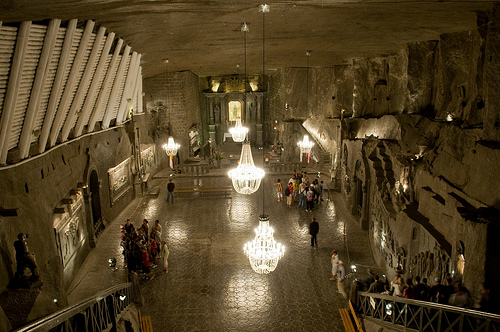

Wieliczka Salt Mine is situated in the town of Wieliczka in Southern Poland. This industrial man made tunnels were dug to extract salt for preservation of food. Wieliczka Salt Mine is most famous for its unique layout, giant halls, underground chapel cut in the layers of salt.
Location: ul. Danilowicza 10 Map
Dimensions: 327 m deep and over 300 km of the corridors
Tel. 012 278 73 02
Open: Apr- Oct: 7:30am- 7:30pm
Nov- Mar: 8am- 5pm
Closed: 1 Jan, Easter, 1 Nov, 24- 26 Dec, 31 Dec
Town of Wieliczka stands on a site where 15 million old sea once splashed. After the water retreated salt water was trapped and eventually water evaporated, leaving layers of sea salt. These deposits were covered by soil, but due to close proximity to Earth's surface it was fairly easily accessible even with technology of the Medieval people.
First mention of mining in the region of town of Wieliczka comes from 1044, when Polish King Casimir the Great gave privilige to local residents to mine underground "magnum sal alias Wieliczka". Wieliczka Salt Mine was a source of salt for Poland and much of Europe since 13th century. In fact this massive ancient sea deposit was quarried for several centuries until all operations ceased only in 2007. After centuries of digging and cutting through deposits left by an ancient oceans people managed to create a network of man made tunnels that reached 327 m deep and over 300 km of the corridors. However the main feature of the salt mines is an underground cathedral with adjacent rooms and chapels that were carved entirely out of surrounding salt deposits.
Tourist route to Wieliczka Salt Mine is divided into 3 parts and leads to the depth of 135 meters below surface level. It starts with Danilovich Mine that was used to deliver salt to the surface. Excursion further goes to explore about 20 rooms and halls of various size. Some of these rooms are dedicated to various historic figures from the Polish and World history including famous astronomer Nicolaus Copernicus, Casimir the Great, Jan Halushki and many others. It is not the whole complex of artificial tunnels, but other parts of Wieliczka Salt Mine are not secure for tourists and have no lighting. Keep in mind that the temperature underground usually stays around 14 degrees Celcius year round so take something to keep you warm.
Main sights in Wieliczka Salt Mine
 1.
Danilovich Shaft
1.
Danilovich Shaft
2. Adjacent shaft to Danilovich Shaft
3. Chamber of Nicholas Copernicus
4. Chamber of Saint Antonius
5. Yanovytse Chamber
6. Burnt Chamber
7. Selets Chamber
8. Casimir the Great Chamber
9. Peskova Skala
12. Chapel of the Holy Cross
13. Chapel of Saint Kinga
14. Erasmus Baronch Chamber
15. Michalowice Chamber
16. Drozdowice Chamber
17. Weimer Chamber
18. Jozef Pilsudski Chamber
20. Staszica Chamber
21. Treasurer Chamber
22. Witold Budryk Chamber
23. Warsaw Chamber
24. Vistula Chamber
26. Yan Halushki Chamber
27. Isabella Chamber
Chapel of the Holy Kinga (Book)
Chapel of the Holy Kinga is widely known simply as an Underground Church. It is a Roman Catholic chapel that was dug from solid salt deposits in 1896 for workers of Wieliczka Salt Mine following an initiative of Josef Markovski. Small chapel was dedicated to Kinga (Kunigunde) of Hungary, patroness of Polish salt miners.
Chapel of the Holy Kinga is located at a depth of 101 meters below ground. It measures 54 meters by 18 meters with a height of 12 meters. Small shrine was cut in the salt deposit. Miners managed also to create salt sculptures of venerated Christian saints including Saint Kinga, Saint Joseph, Saint Clemens and of course Roman pope John Paul II. Famous pope was ethnically Polish and he is still a source of pride for Polish citizens. Several "paintings" were also carved from the rock depicting various scenes from the Bible including a copy of Leonardo da Vinci's "Last Supper". One of the most striking elements in the interior of the church is unusual chandelier, which is made from salt crystals carved by hand by several salt miners who worked in Wieliczka Salt Mine.
Chamber of Casimir the Great
Chamber of Casimir the Great was carved into the rock salt in the early 18th century. It acquired its name in 1968. Technically its has nothing to do with the famous king, but museum workers decided to honor memory of the monarch who first started salt mining industry in Wieliczka. Today it also keeps a bust of a Medieval King.
Danilovich Shaft
Danilovich Shaft was carved in the 1635- 40's when Wieliczka Salt Mine was run by Nikolai Danilovich. It served to transport barrels of salt to the surface with help of horses that pushed the rising mechanism. In the 19th century it was used to transport workers and first tourists. Wooden structure above ground was built in 1874 and later replaced by a stone structure. About the same time a first steam engine replaced horse power. After World War II steam engine was replaced by an electric lifting machine.
Chamber of Nicolas Copernicus
Chamber of Nicolas Copernicus is dedicate to a famous Polish astronomer and scientist who proposed heliocentric vision of the Solar System, where Sun and not the Earth stayed in the center, while other planets moved around it. It is most famous for salt sculpture of Nicolas Copernicus that was installed here to mark 500 year anniversary of the birth of the astronomer. The chamber itself was cut in 1875.
Chapel of Saint Anthony
Underground Chapel of Saint Anthony was created at the end of the 17th century. The first recorded service here was held in 1698. This small church in Wieliczka Salt Mine contains several sculptures of Crucified Christ, Holy Virgin with small Jesus and Saint Anthony, patron of the chapel. Unfortunately many statues were badly eroded by moisture in the air.